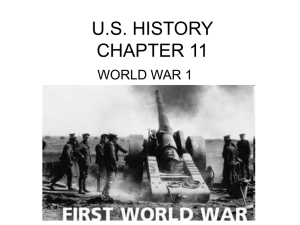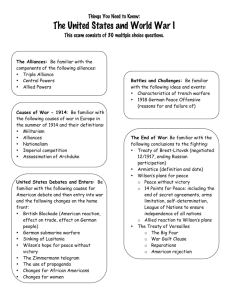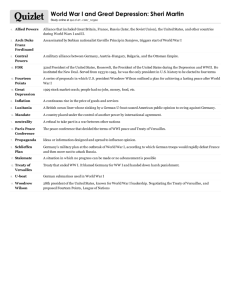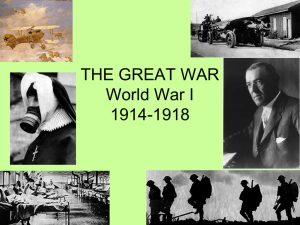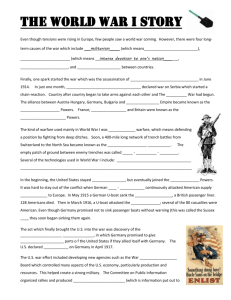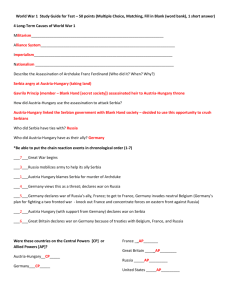1914 -
advertisement
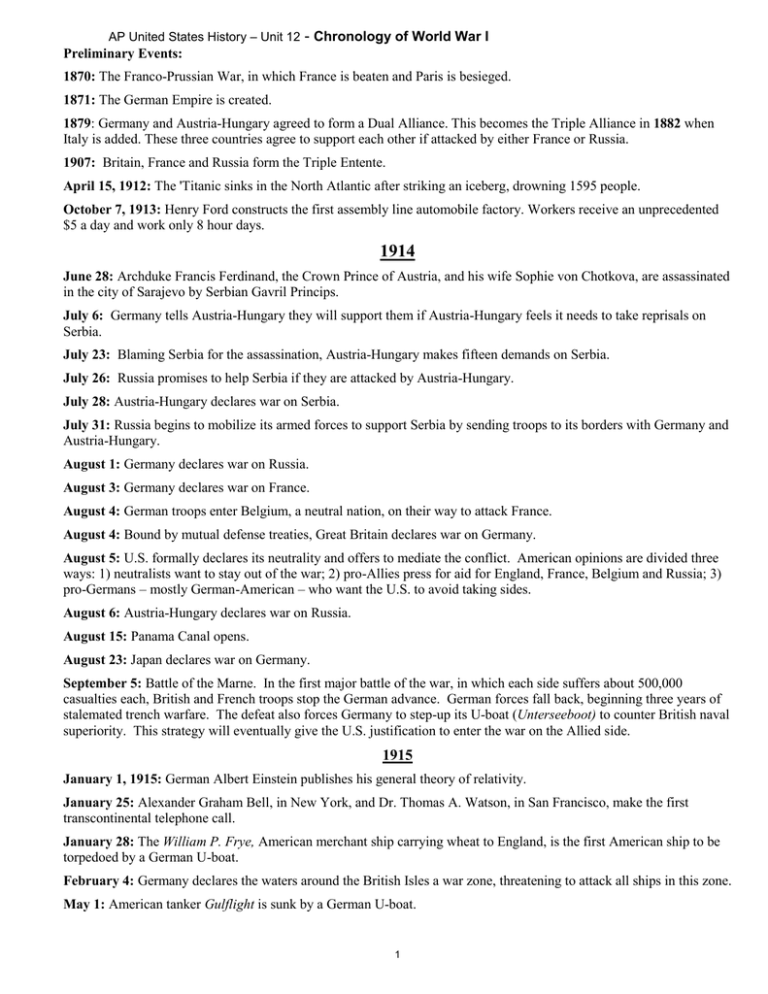
AP United States History – Unit 12 - Chronology of World War I Preliminary Events: 1870: The Franco-Prussian War, in which France is beaten and Paris is besieged. 1871: The German Empire is created. 1879: Germany and Austria-Hungary agreed to form a Dual Alliance. This becomes the Triple Alliance in 1882 when Italy is added. These three countries agree to support each other if attacked by either France or Russia. 1907: Britain, France and Russia form the Triple Entente. April 15, 1912: The 'Titanic sinks in the North Atlantic after striking an iceberg, drowning 1595 people. October 7, 1913: Henry Ford constructs the first assembly line automobile factory. Workers receive an unprecedented $5 a day and work only 8 hour days. 1914 June 28: Archduke Francis Ferdinand, the Crown Prince of Austria, and his wife Sophie von Chotkova, are assassinated in the city of Sarajevo by Serbian Gavril Princips. July 6: Germany tells Austria-Hungary they will support them if Austria-Hungary feels it needs to take reprisals on Serbia. July 23: Blaming Serbia for the assassination, Austria-Hungary makes fifteen demands on Serbia. July 26: Russia promises to help Serbia if they are attacked by Austria-Hungary. July 28: Austria-Hungary declares war on Serbia. July 31: Russia begins to mobilize its armed forces to support Serbia by sending troops to its borders with Germany and Austria-Hungary. August 1: Germany declares war on Russia. August 3: Germany declares war on France. August 4: German troops enter Belgium, a neutral nation, on their way to attack France. August 4: Bound by mutual defense treaties, Great Britain declares war on Germany. August 5: U.S. formally declares its neutrality and offers to mediate the conflict. American opinions are divided three ways: 1) neutralists want to stay out of the war; 2) pro-Allies press for aid for England, France, Belgium and Russia; 3) pro-Germans – mostly German-American – who want the U.S. to avoid taking sides. August 6: Austria-Hungary declares war on Russia. August 15: Panama Canal opens. August 23: Japan declares war on Germany. September 5: Battle of the Marne. In the first major battle of the war, in which each side suffers about 500,000 casualties each, British and French troops stop the German advance. German forces fall back, beginning three years of stalemated trench warfare. The defeat also forces Germany to step-up its U-boat (Unterseeboot) to counter British naval superiority. This strategy will eventually give the U.S. justification to enter the war on the Allied side. 1915 January 1, 1915: German Albert Einstein publishes his general theory of relativity. January 25: Alexander Graham Bell, in New York, and Dr. Thomas A. Watson, in San Francisco, make the first transcontinental telephone call. January 28: The William P. Frye, American merchant ship carrying wheat to England, is the first American ship to be torpedoed by a German U-boat. February 4: Germany declares the waters around the British Isles a war zone, threatening to attack all ships in this zone. May 1: American tanker Gulflight is sunk by a German U-boat. 1 AP United States History – Unit 12 - Chronology of World War I May 7: British ocean liner Lusitania is sunk by a U-boat. Nearly 1,200 of the 1,900 passengers aboard die, of whom 128 are Americans. In a series of notes to Germany, Wilson warns against infringement of American rights on the high seas. Secretary of State William Jennings Bryan, a pacifist, resigns as a protest against what he sees as U.S. favoritism towards the Allies. July 2: A former professor of German at Harvard University, Erich Muenter explodes a bomb in the empty U.S. Senate, and the next day shoots J.P. Morgan, Jr., further arousing anti-German sentiment in the U.S. July 25: American merchant ship Leelanaw is sunk by a U-boat. September 1: “Arabic pledge” - Germany promises not to sink unarmed ocean liners following sinking of British ocean liner Arabic December 7: President Wilson requests a standing army of 142,000 men, and reserves of 400,000. 1916 January 7: Responding to American pressure, Germany pledges to abide by international rules of naval warfare. February 2: A congressional resolution warns Americans to avoid travel on ships owned by warring nations. March 15: Army Reorganization Act passed by Congress: Army will be brought to a strength of 175,000 and National Guard to 450,000 by end of June. April 20: With German assistance, what becomes known as the Easter Uprising begins in Ireland. British troops quickly put it down. May 31: “Sussex pledge” - Following sinking of French steamer Sussex, Germany again agrees to "visit and search" rules, but insists that Great Britain should also agree to obey international laws regarding freedom of the seas June 16: Under the slogan “He kept us out of war,” Democratic Party re-nominates Woodrow Wilson, running against Republican Charles Evans Hughes, who has the strong support of Teddy Roosevelt. July 29: U.S. troops sent to Haiti August 14: U.S. purchases the Virgin Islands for $25 million from Denmark. November 7: Wilson, by a slim popular and electoral vote, wins re-election. 1917 January 22: In a speech to Congress, President Wilson calls for "peace without victory" because he is convinced that both sides needed to cease hostilities. Speech also calls for a league of peace, an organization to promote the resolution of conflicts between nations. January 31: Germany resumes unrestricted submarine warfare, believing it can starve the Allies into submission in six months. February 3: Citing Germany’s decision to resume unrestricted submarine warfare, President Wilson breaks off diplomatic relations with Germany. He says he will wait for an overt act by the German government showing that Germany wanted war with the U.S. before he would request a declaration of war. February 24: *“Zimmerman letter” – British Secret Service release an intercepted telegram from German Foreign Minister Arthur Zimmerman to the German Ambassador in Mexico, attempting to incite Mexico to join Germany’s side should the U.S. enter the war against Germany. In return, Germany promises to help recover Texas, New Mexico, and Arizona. 2 AP United States History – Unit 12 - Chronology of World War I March 9: President Wilson orders all U.S. merchant ships to be armed. March 12-21: Five more American ships are sunk, all without warning. March 15: The Tsar of Russia is forced to abdicate after the Russian Revolution. U.S. government recognizes the new Russian government formed by Aleksander Kerensky. March 20: President Wilson's war cabinet votes unanimously in favor of declaring war on Germany April 2: *President asks Congress to declare war on Germany [see “Voices from the past,” Chapter 31 term sheet]. April 6: By a vote of 374 – 50, Congress declares war on Germany. Joint Resolution Declaring that a state of war exists between the Imperial German Government and the Government and the people of the United States and making provision to prosecute the same. Whereas the Imperial German Government has committed repeated acts of war against the Government and the people of the United States of America; Therefore be it Resolved by the Senate and the House of Representatives of the United States of America in Congress Assembled, that the state of war between the United States and the Imperial German Government which has thus been thrust upon the United States is hereby formally declared; and that the President be, and he is hereby, authorized and directed to employ the entire naval and military forces of the United States and the resources of the Government to carry on war against the Imperial German Government; and to bring the conflict to a successful termination all of the resources of the country are hereby pledged by the Congress of the United States. CHAMP CLARK Speaker of the House of Representatives THOS. R. MARSHALL Vice President of the United States and President of the Senate Approved, April 6, 1917 WOODROW WILSON May: Food Administration formed. Herbert Hoover heads effort to conserve food and boost agricultural output. May: Creel Committee issues official propaganda. Daily "Official Bulletins" seek to convince Americans of the crusade for freedom and democracy and the bestial nature of the "Huns." May: War Industries Board created. Led by Bernard Baruch, the WIB set prices and determined what goods should be produced by private industry. May 18: Selective Service Act is passed, authorizing the registration and drafting of males between 21 and 30. Nearly 10 million men are listed and a lottery chooses first 687,000 to serve. Eventually 3,000,000 men serve as draftees in the war. May 28: General John J. “Black Jack” Pershing leaves New York for France to prepare for arrival of American troops. June: Espionage Act is passed by Congress, supposedly to prevent spying. But it is chiefly used to silence American critics of the war, such as Socialist leader Eugene Debs. June 25: First U.S. troops ( U.S. 1st Division) arrive in France. November 6: Led by Lenin, the Bolsheviks overthrow the Kerensky government in Russia; United States denies recognition of the Bolshevik government. 3 AP United States History – Unit 12 - Chronology of World War I December 3: The new Russian government, represented by Leon Trotsky, signs an armistice with Germany. December 7: United States declarers war on Austria-Hungary. 1918 January 8: In an attempt to settle the war, Woodrow Wilson announces his *Fourteen Points peace program. The last of the Fourteen Points states “A general association of nations must be formed under specific covenants for the purpose of affording mutual guarantees of political independence and territorial integrity to great and small states alike.” Allied nations largely ignore the speech. March 21: Hoping to achieve victory before U.S. forces can be fully involved. Germany launches a massive offensive on the Western Front (the Eastern Front is closed when Russia signs an armistice with Germany Dec. 3). July 17: Allies halt the German offensive in the Second Battle of the Marne. August 10: General Pershing establishes an independent American army. September 14: American forces begin their first independent action. September 26: More than one million Allied troops, including 896,000 Americans, join for an offensive in the last major battle of the war. Casualties reach 120,000. October 3: Germany forms a parliamentary government as the army collapses and the navy mutinies. The Kaiser abdicates, and Germany begins peace overtures based on Wilson’s Fourteen Points. October 30: Austria asks Italy for an armistice and surrenders on November 4. November 11: Germany signs an armistice treaty at 5:00 AM, and six hours later, at the “eleventh hour of the eleventh day of the eleventh month,” fighting ends. 1919 June 28: Treaty of Versailles is signed. Germany is required to admit its guilt, return the rich Alsace-Lorraine region to France, surrender her overseas colonies, and pay reparations of some $32 billion. Germany rearmament is strictly limited and the Allies take temporary control of Germany’s economy. A League of Nations is formed. July 10: President Wilson hand-delivers the treaty to the Senate, and then addressed the chamber. The treaty is referred to the Foreign Relations Committee, which holds public hearings from July 31 to September 12. President Wilson testifies on August 19 when he receives Chairman Henry Cabot Lodge and fifteen committee members (including future President Warren G. Harding) in the East Room of the White House. Lodge writes that the President “took the questioning, which was rather sharp at times, in good part, although at the end . . . he seemed very much fatigued.” September 16: Senator Lodge calls up the treaty for consideration of the full Senate. September 25: On a cross-country tour to promote popular support for the Versailles Treaty and the League of Nations, President Wilson suffers a stroke. Only a very few people are told of the seriousness of his illness; his wife Edith makes some presidential decisions in his name while he is ill. By November 1 Wilson is sufficiently recovered to resume control. November 15, the chamber is still considering the treaty when, for the first time in its history, the Senate votes to invoke cloture – or cut off debate – on the treaty. Four days later, the Senate takes up Lodge’s resolution of ratification, which includes fourteen reservations to the treaty. The Lodge resolution fails on a 39 - 55 vote. The Senate then considers a resolution to approve the treaty without reservations of any kind, which fails on a 38-53 vote. After 55 days of debate, the Senate has rejected the Treaty of Versailles. The League of Nations is underway but the United States is not part of it. August, 1921: The United States negotiates a separate peace with Germany. *=A 100 Milestone Document from the National Archive. Go to Webpage to link to these documents. 4 AP United States History – Unit 12 - Chronology of World War I Casualties of the First World War Country Mobilized Killed Wounded Total Africa1 Australia Austria-Hungary* Belgium* Bulgaria* Canada The Caribbean2 French Empire* Germany* Great Britain* Greece* India3 Italy* Japan* Montenegro* New Zealand Portugal* Romania* Russia* Serbia* South Africa Turkey* USA* 55,000 330,000 6,500,000 207,000 400,000 620,000 21,000 7,500,000 11,000,000 5,397,000 230,000 1,500,000 5,500,000 800,000 50,000 110,000 100,000 750,000 12,000,000 707,000 149,000 1,600,000 4,272,500 10,000 59,000 1,200,000 13,000 101,000 67,000 1,000 1,385,000 1,718,000 703,000 5,000 43,000 60,000 250 3,000 18,000 7,000 200,000 1,700,000 128,000 7,000 336,000 117,000 unknown 152,000 3,620,000 44,000 153,000 173,000 3,000 4,266,000 4,234,000 1,663,000 21,000 65,000 947,000 1,000 10,000 55,000 15,000 120,000 4,950,000 133,000 12,000 400,000 204,000 unknown 211,000 4,820,000 57,000 254,000 241,000 4,000 5,651,000 5,952,000 2,367,000 26,000 108,000 1,407,000 1,250 13,000 73,000 22,000 320,000 6,650,000 261,000 19,000 736,000 321,000 Casualties % Of Mobilized 64% 74% 28% 64% 39% 19% 75% 54% 44% 11% 7% 26% 0.2% 26% 66% 22% 43% 55% 37% 13% 46% 8% * . Statistics cited from The Longman Companion to the First World War (Colin Nicholson, Longman 2001, pg. 248); they have been rounded to the nearest thousand. All percentages are my own; they refer to the % of the total mobilized. 1 . The figure of 55,000 refers to soldiers who saw combat; the number of Africans involved as auxiliaries or otherwise is likely to include several hundred thousand. Troops were drawn from Nigeria, Gambia, Rhodesia/Zimbabwe, Sierra Leone, Uganda, Nyasaland/Malawi, Kenya and the Gold Coast. Figures for South Africa are given separately. 2 . The British West Indies regiment drew men from across the Caribbean, including Barbados, Bahamas, Honduras, Grenada, Guyana, Leeward Islands, St. Lucia, St. Vincent and Trinidad and Tobago; the bulk came from Jamaica. Influenza pandemic in 1918 and 1919: A separate, but related event was the great influenza pandemic. A new strain of Influenza, originating in the U.S.A. (but misleadingly known as "Spanish Flu") was accidentally carried to Europe with the American forces. The disease spread rapidly through the both the continental U.S. and Europe, reaching, eventually, around the globe. The exact number of deaths is unknown, but in excess of 20 million people worldwide is not considered an overestimate. 5 AP United States History – Unit 12 - Chronology of World War I The Face of Europe Changes Europe – 1914 Europe - 1919 6
